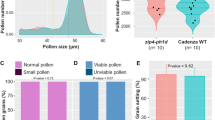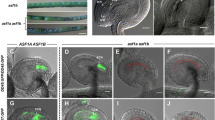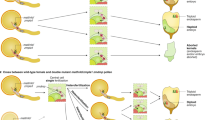Abstract
Doubled haploid technology can accelerate plant breeding and its two main steps are haploid induction and subsequent doubled haploid production from fertile haploid plants. Although haploid female fertility is present to some extent in plants, the lack of haploid male fertility is a bottleneck. Herein, we demonstrate that mutations in the parallel spindle genes are sufficient to restore haploid male fertility in Arabidopsis with no impact on haploid female fertility.
This is a preview of subscription content, access via your institution
Access options
Access Nature and 54 other Nature Portfolio journals
Get Nature+, our best-value online-access subscription
$29.99 / 30 days
cancel any time
Subscribe to this journal
Receive 12 digital issues and online access to articles
$119.00 per year
only $9.92 per issue
Buy this article
- Purchase on Springer Link
- Instant access to full article PDF
Prices may be subject to local taxes which are calculated during checkout


Similar content being viewed by others
Data availability
The authors declare that all data supporting the findings of this study are available within the manuscript.
Code availability
The R scripts used for statistical analysis are also available within the manuscript.
References
Ravi, M. & Chan, S. W. L. Haploid plants produced by centromere-mediated genome elimination. Nature 464, 615–618 (2010).
Dunwell, J. Haploids in flowering plants: origins and exploitation. Plant Biotechnol. J. 8, 377–424 (2010).
Chaikam, V., Martinez, L., Melchinger, A. E., Schipprack, W. & Boddupalli, P. M. Development and validation of red root marker‐based haploid inducers in maize. Crop Sci. 56, 1678–1688 (2016).
Lv, J. et al. Generation of paternal haploids in wheat by genome editing of the centromeric histone CENH3. Nat. Biotechnol. 38, 1397–1401 (2020).
Cifuentes, M., Rivard, M., Pereira, L., Chelysheva, L. & Mercier, R. Haploid meiosis in Arabidopsis: double-strand breaks are formed and repaired but without synapsis and crossovers. PLoS ONE 8, e72431 (2013).
Sugihara, N., Higashigawa, T., Aramoto, D. & Kato, A. Haploid plants carrying a sodium azide-induced mutation (fdr1) produce fertile pollen grains due to first division restitution (FDR) in maize (Zea mays L.). Theor. Appl. Genet. 126, 2931–2941 (2013).
Boerman, N. A., Frei, U. K. & Lübberstedt, T. Impact of spontaneous haploid genome doubling in maize breeding. Plants (Basel) 9, 369 (2020).
Morgan, D. T. Jr. Female fertility of haploid peppers. Cytologia 40, 623–626 (1975).
De Storme, N. & Geelen, D. The Arabidopsis mutant jason produces unreduced first division restitution male gametes through a parallel/fused spindle mechanism in meiosis II. Plant Physiol. 155, 1403–1415 (2011).
d’Erfurth, I. et al. Mutations in AtPS1 (Arabidopsis thaliana Parallel Spindle 1) lead to the production of diploid pollen grains. PLoS Genet. 4, e1000274 (2008).
Hartung, F. et al. The catalytically active tyrosine residues of both SPO11-1 and SPO11-2 are required for meiotic double-strand break induction in Arabidopsis. Plant Cell 19, 3090–3099 (2007).
Grelon, M., Vezon, D., Gendrot, G. & Pelletier, G. AtSPO11-1 is necessary for efficient meiotic recombination in plants. EMBO J. 20, 589–600 (2001).
Erilova, A. et al. Imprinting of the polycomb group gene MEDEA serves as a ploidy sensor in Arabidopsis. PLoS Genet. 5, e1000663 (2009).
Mieulet, D. et al. Turning rice meiosis into mitosis. Cell Res. 26, 1242–1254 (2016).
Chalyk, S. T. Properties of maternal haploid maize plants and potential application to maize breeding. Euphytica 79, 13–18 (1994).
Geiger, H. et al. Variation for female fertility among haploid maize lines. Maize Genet. Coop. News Lett. 80, 28–29 (2006).
Cigliano, R. A., Sanseverino, W., Cremona, G., Consiglio, F. M. & Conicella, C. Evolution of Parallel Spindles Like genes in plants and highlight of unique domain architecture. BMC Evol. Biol. 11, 78 (2011).
Cabout, S. et al. The meiotic regulator JASON utilizes alternative translation initiation sites to produce differentially localized forms. J. Exp. Bot. 68, 4205–4217 (2017).
Kelliher, T. et al. One-step genome editing of elite crop germplasm during haploid induction. Nat. Biotechnol. 37, 287–292 (2019).
Zhong, Y. et al. A DMP-triggered in vivo maternal haploid induction system in the dicotyledonous Arabidopsis. Nat. Plants 6, 466–472 (2020).
Murashige, T. & Skoog, F. A revised medium for rapid growth and bio assays with tobacco tissue cultures. Physiol. Plant 15, 473–497 (1962).
Ravi, M. & Bondada, R. in Chromosome and Genomic Engineering in Plants: Methods and Protocols Vol. 1469 (ed. Murata, M.) (Springer, 2016).
Dolezel, J., Greilhuber, J. & Suda, J. Estimation of nuclear DNA content in plants using flow cytometry. Nat. Protoc. 2, 2233–2244 (2007).
Peterson, R., Slovin, J. P. & Chen, C. A simplified method for differential staining of aborted and non-aborted pollen grains. Int. J. Plant Biol. 1, 66–69 (2010).
Patil, I. Visualizations with statistical details: the ‘ggstatsplot’ approach. J. Open Source Softw. 6, 3167 (2021).
Acknowledgements
We acknowledge the Iowa State University Office of Biotechnology Flow Cytometry Facility for assistance with ploidy analysis and the Arabidopsis Biological Resource Centre (Columbus, OH) for T-DNA insertion lines. This work was supported by the Foundation for Food & Agriculture Research under award number CA19-SS-0000000128 to T.L. The content of this manuscript is solely the responsibility of the authors and does not necessarily represent the official views of the Foundation for Food & Agriculture Research. T.L. also acknowledges the support from Iowa State University Plant Sciences Institute.
Author information
Authors and Affiliations
Contributions
S.I.A. and T.L. conceived the research. S.I.A. and L.Z. performed experiments and analysed data. All authors wrote the manuscript.
Corresponding author
Ethics declarations
Competing interests
The authors declare no competing interests.
Peer review
Peer review information
Nature Plants thanks Jing Li, Jian Lv and the other, anonymous, reviewer(s) for their contribution to the peer review of this work.
Additional information
Publisher’s note Springer Nature remains neutral with regard to jurisdictional claims in published maps and institutional affiliations.
Extended data
Extended Data Fig. 1 Cartoon of proposed cytological mechanism restoring HMF in ps mutants.
Only three chromosomes (violet, blue and gray colors) are shown for simplicity. Homologous chromosomes (light colors) are present only in diploid (a). Spindle fibers are shown in orange color. Dotted lines denote the poles to where chromatids will migrate. At the end of meiosis I, chromosomes are equally distributed in diploids (a) but unequally distributed in haploids (b and c) resulting in unbalanced meiotic products in WT haploids (b). In ps mutant haploids, however, the unequal distribution in meiosis I is ‘corrected’ by parallel spindles during metaphase II leading to dyad formation with balanced meiotic products (c). Figure created with BioRender.com.
Extended Data Fig. 2 Ploidy analysis by flow cytometry in ps mutant and WT haploids.
Representative histograms from ploidy analysis of leaf sample of the putative haploids derived from crosses with cenh3 haploid inducer and respective mutants as indicated. 1C, 2C, 4C and 8C refer to the copy numbers of chromosomes in the nuclei analyzed and they were assigned by comparing to a known diploid WT control.
Extended Data Fig. 3 ps mutant and WT haploids are morphologically indistinguishable.
Representative pictures of 4-week old ps mutant and WT haploids displaying indistinguishable morphology from one another during their vegetative growth. Scale bar = 3 cm.
Extended Data Fig. 4 Representative histograms from ploidy analysis of leaf tissue of putative doubled haploids.
(a) A pool of 4 plants were analysed for each of the indicated genotypes and a total of 32 plants were used. (b) Each pool was co-analysed together with a 2n WT sample as an internal control. 2C, 4C and 8C refer to the copy numbers of chromosomes in the nuclei analyzed and they were assigned by comparing to a known diploid WT control.
Extended Data Fig. 5 Representative gating of nuclei using a combination of light scatter and fluorescence properties.
(a) Scatter plot comparing the relative size of nuclei from debris using forward scatter (FSC-A) and DNA fluorescence (y-axis). (b) Scatter plot comparing the relative granularity/complexity of nuclei from debris using side scatter (SSC-A) and DNA fluorescence (x-axis). Gates drawn (in a and b) exemplify the selected nuclei based on their light scatter and DNA fluorescence properties. c) Count of nuclei with different relative DNA content resulting from the gating described (in a and b).
Supplementary information
Supplementary Information
Supplementary Table 1.
Supplementary Code
R script used for statistical analysis.
Source data
Source Data Fig. 1
Statistical source data.
Rights and permissions
Springer Nature or its licensor (e.g. a society or other partner) holds exclusive rights to this article under a publishing agreement with the author(s) or other rightsholder(s); author self-archiving of the accepted manuscript version of this article is solely governed by the terms of such publishing agreement and applicable law.
About this article
Cite this article
Aboobucker, S.I., Zhou, L. & Lübberstedt, T. Haploid male fertility is restored by parallel spindle genes in Arabidopsis thaliana. Nat. Plants 9, 214–218 (2023). https://doi.org/10.1038/s41477-022-01332-6
Received:
Accepted:
Published:
Issue Date:
DOI: https://doi.org/10.1038/s41477-022-01332-6



